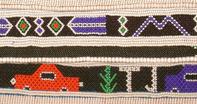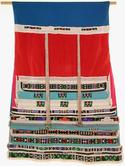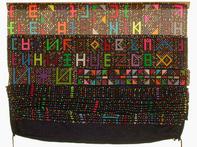
Ndebele C 1940 Hide and glass beads Height 50 cm Width: 49.5 cm This almost square apron is covered in white beads using the ‘lazy stitch’ method.
Ndebele women used various types of aprons at different stages of their lives, including puberty and marriage. Aprons like this one, known as a liphotho, were worn by married women.
These women generally owned two kinds of beaded aprons, the liphotho, and another, known as ijogolo. Women also wore beaded skin capes or blankets on special occasions such as the return of their sons from initiation.
Married Woman's Cape

Lower Drakensberg Region of Kwa-Zulu/Natal Probably 1970s Traditionally, married women from rural Zulu-speaking communities covered their shoulders out of respect for the ancestors.
Garments worn for this purpose on special occasions were commonly beaded. Those from the lower Drakensberg region, where this cloak is called an isibhklane, sometimes include beadwork panels obtained from older garments.
Women also sewed additional, newly-beaded panels onto their cloaks over time.
Pictorial motifs are comparatively rare, but some capes include allusions to migrant partners working in cities like Johannesburg, where cars formerly had number plates preceded by the initials, TJ, i.e. Transvaal, Johannesburg.


Valley of a Thousand Hills region of Kwa-Zulu/Natal The capes traditionally worn on special occasions by married women from Zulu-speaking communities varied significantly in style from one region to another.
In the course of the 1970s in the Valley of a Thousand Hills, between Durban and Pietermaritzburg, it became increasingly common for these capes to be fashioned from locally-manufactured plastic beads.
Beadwork capes from this region were typically worn in combination with long, beaded necklaces displaying proverbs identifying the personal concerns and aspirations of the wearer.
By Professor Sandra Klopper